|
|
|
|
ECOSYSTEM SERVICES AS A BASIS FOR CLIMATE ADAPTATION INDICATORS: A CASE FROM URBAN INDIA
Shaila Naaz 1![]()
![]() ,
Dr. Nirmita Mehrotra 2
,
Dr. Nirmita Mehrotra 2![]()
1 Research
Scholar, Gautam Buddha University, Gautam Buddh
Nagar, Uttar Pradesh, India
2 Head,
Department of Urban and Regional Planning, Gautam Buddha University, Gautam Buddh Nagar, Uttar Pradesh, India
|
|
ABSTRACT |
||
|
Climate change
poses significant threats to urban sustainability, particularly in rapidly
growing cities where ecological degradation amplifies vulnerability to
extreme weather events. Ecosystem services (ES)—the benefits derived from
natural systems—offer a vital framework for developing climate adaptation
strategies by linking ecological functions with human well-being. This study
explores how ecosystem services can serve as a basis for identifying and
evaluating climate adaptation indicators. Through an integrative review of
literature and case-based analysis, the research highlights the role of
provisioning, regulating, cultural, and supporting services in enhancing
adaptive capacity. The final set of indicators was established following a
comprehensive data collection process involving surveys and questionnaires
administered to key stakeholders. These stakeholders comprised professionals
from relevant fields, specifically urban planners, policy makers, architects,
urbanists, urban designers, urban foresters, and individuals engaged in the
urban infrastructure sector." Indicators such as urban green cover,
water retention potential, biodiversity index, carbon sequestration, and
social access to green infrastructure are identified as measurable parameters
for adaptation assessment. The findings emphasize that embedding ecosystem
service-based indicators within urban planning can improve resilience,
promote sustainable land-use management, and support evidence-based policy
formulation. By positioning ecosystem services at the core of adaptation
frameworks, cities can transition from reactive to proactive climate
governance that synergizes ecological health with socio-economic
sustainability. |
|||
|
Received 05 August 2025 Accepted 20 September 2025 Published 31 October 2025 Corresponding Author Ar.
Shaila Naaz, khanshailanaaz@gmail.com DOI 10.29121/ijetmr.v12.i10.2025.1687 Funding: This research
received no specific grant from any funding agency in the public, commercial,
or not-for-profit sectors. Copyright: © 2025 The
Author(s). This work is licensed under a Creative Commons
Attribution 4.0 International License. With the
license CC-BY, authors retain the copyright, allowing anyone to download,
reuse, re-print, modify, distribute, and/or copy their contribution. The work
must be properly attributed to its author.
|
|||
|
Keywords: Ecosystem Services,
Climate Adaptation, Urban Resilience, Adaptation Indicators, Sustainable
Planning, Ecosystem-Based Adaptation |
|||
1. INTRODUCTION
Climate change is one of the most pressing challenges of the 21st century, especially in rapidly urbanising regions where vulnerabilities are compounded by population growth, resource stress, and ecosystem degradation IPCC (2022). Cities, while major contributors to greenhouse gas emissions, are also hotspots of climate risks, including heatwaves, flooding, water scarcity, and deteriorating air quality Revi et al. (2014). In this context, urban ecosystem services (UES) the benefits humans derive from ecosystems, are increasingly recognised as essential assets for climate adaptation MEA (2005), Elmqvist et al. (2015). These services provide regulatory, provisioning, cultural, and supporting functions that enable urban populations to mitigate and adapt to climate impacts.
Ecosystem-based adaptation (EbA) emphasises integrating ecosystem services into climate resilience strategies Munang et al. (2013). Urban green spaces, wetlands, and tree cover regulate microclimates, reduce stormwater runoff, sequester carbon, and offer psychological and cultural benefits Kabisch et al. (2016), Haase et al. (2014). However, urban development trajectories in the Global South often marginalise ecological considerations in favour of grey infrastructure, reducing the effectiveness of ecosystems in climate mitigation and adaptation Nagendra et al. (2018). This creates a pressing need to develop measurable indicators that explicitly capture the role of ecosystem services in urban climate adaptation strategies. Indicators translate complex ecological and social dynamics into actionable information for planners, policymakers, and communities Singh et al. (2021). Although global frameworks such as the Sustainable Development Goals (SDGs) and the Convention on Biological Diversity highlight the importance of ecosystem services, their operationalisation into urban climate adaptation indicators remains limited in India Pandey et al. (2018). Developing robust indicators requires not only ecological data but also insights into local perceptions, socio-economic realities, and governance structures. Urban India exemplifies the urgent need for ecosystem service-based indicators. Rapid urbanisation has led to wetland encroachment, declining tree cover, and the loss of urban commons, undermining the capacity of ecosystems to provide climate-regulating services Singh et al. (2021), Sharma and Tomar (2010). Identifying and operationalising ecosystem service-based indicators can provide a pathway for embedding resilience into urban planning. By aligning adaptation strategies with local ecological functions and socio-cultural priorities, cities can move toward more sustainable, climate-resilient futures. This study contributes to the field by developing ecosystem service-based climate adaptation indicators for urban India using a mixed-methods approach. By combining qualitative interviews and quantitative surveys, it identifies, evaluates, and prioritises indicators that can inform urban policy and planning, bridging the gap between ecological theory, indicator frameworks, and practical urban realities.
1.1. BACKGROUND & LITERATURE REVIEW
1.1.1. Urban Ecosystem Services and Climate Adaptation
Urban ecosystem services (UES) refer to the diverse benefits that humans derive from ecosystems in urban environments, including provisioning, regulating, supporting, and cultural services MEA (2005), Gómez-Baggethun and Barton (2013). Regulating services, such as microclimate moderation, stormwater management, and air purification, directly support climate adaptation by reducing urban vulnerabilities, while cultural and supporting services contribute to well-being, recreation, and biodiversity conservation Elmqvist et al. (2015), Haase et al. (2014). Ecosystem-based adaptation (EbA) integrates these services into urban resilience strategies, aiming to enhance adaptive capacity while maintaining ecological integrity Munang et al. (2013). Urban green spaces, wetlands, and urban forests, for example, mitigate the urban heat island effect, regulate hydrological cycles, sequester carbon, and provide recreational and psychological benefits to residents McPhearson et al. (2016). Despite these benefits, urban development in rapidly growing cities, particularly in the Global South, often prioritises infrastructural expansion over ecological conservation, limiting the effectiveness of UES in adaptation planning Nagendra et al. (2018).
1.1.2. Indicators for Climate Adaptation
Indicators are measurable parameters that translate complex ecological and social data into actionable information for policymakers, planners, and communities Singh et al. (2021). They provide a mechanism for monitoring, evaluation, and adaptive management of urban ecosystems and climate adaptation initiatives. Global frameworks such as the Sustainable Development Goals (SDGs) and the Convention on Biological Diversity stress the importance of using indicators to operationalise ecosystem services for sustainable and climate-resilient urban development Pandey et al. (2018). In India, while several studies have focused on mapping and valuing ecosystem services, few have operationalised these insights into measurable climate adaptation indicators. Most existing work is either ecological or theoretical, with limited integration of socio-economic realities and public perceptions, which are critical for locally relevant and actionable indicators Singh et al. (2021), Sharma and Tomar (2010).
1.1.3. Public Awareness and Perception of Ecosystem Services
Awareness and perception of UES among urban residents significantly influence the success of adaptation strategies Andersson et al. (2014). Research shows that individuals who understand the ecological, social, and economic benefits of urban nature are more likely to support conservation initiatives, participate in urban greening programs, and advocate for policy interventions Ernstson and Sörlin (2013), Buizer et al. (2016). In India, studies indicate that while urban residents value green spaces for recreation and aesthetics, their understanding of regulating services, such as flood control, air purification, and microclimate regulation, is often limited Nagendra et al. (2018), Haase et al. (2014). Integrating public perception into indicator development ensures that climate adaptation strategies are both ecologically sound and socially acceptable. Interviews and surveys provide a critical understanding of community knowledge, experiences, and priorities, informing the selection and prioritisation of UES-based indicators Raymond et al. (2017).
1.1.4. Urban India as a Case Context
India is undergoing rapid urbanisation, with cities facing mounting challenges from ecosystem degradation and heightened climate vulnerabilities. Urban expansion has led to wetland encroachment, declining tree cover, and fragmentation of green spaces, undermining the capacity of ecosystems to deliver climate-regulating services Singh et al. (2020). Indian cities such as Delhi, Mumbai, and Bengaluru illustrate these pressures, where ecological planning is often secondary to infrastructural and commercial demands Sharma and Tomar (2010). Developing ecosystem service-based indicators in this context provides a mechanism to embed resilience into urban planning. By linking ecological functions to measurable metrics, indicators can guide policy, prioritise interventions, and track the effectiveness of climate adaptation strategies Pandey et al. (2018)
1.1.5. Research Gap
Although UES and EbA are increasingly recognised in the literature, few studies in India have operationalised these concepts into practical, measurable indicators that integrate ecological, social, and governance dimensions Nagendra et al. (2018), Singh et al. (2021). Existing research primarily focuses on ecosystem assessment or theoretical frameworks, leaving a gap in context-specific, community-informed indicators. This study addresses this gap by employing qualitative interviews and quantitative surveys to develop locally relevant ecosystem service-based climate adaptation indicators for urban India.
2. MATERIALS AND METHODS
2.1. RESEARCH DESIGN
This study employed a mixed-methods research design, integrating qualitative interviews and quantitative surveys to develop ecosystem service-based indicators for climate adaptation in urban India. The mixed-methods approach allows for the triangulation of data, combining ecological insights with social perceptions to generate robust, context-specific indicators Creswell and Plano Clark (2018). The qualitative component aimed to understand expert perspectives, while the quantitative component assessed broader awareness and knowledge among urban residents.
2.2. STUDY AREA
The study focused on urban India, representing diverse ecological, socio-economic, and infrastructural contexts. Indian cities face rapid urbanisation, climate vulnerabilities, and ecosystem degradation, making them suitable for exploring ecosystem service-based climate adaptation strategies Sharma and Tomar (2010), Singh et al. (2020). Dwarka Sub City in New Delhi has been selected based on ecological significance, vulnerability to climate risks, and availability of urban green infrastructure.
2.3. DATA COLLECTION
1) Qualitative
Interviews
· Purpose: To gather expert knowledge on relevant ecosystem services, their climate adaptation potential, and feasible indicators.
· Participants: Urban planners, environmental scientists, ecologists, and local government officials.
· Method: Semi-structured interviews conducted online and in-person, allowing flexibility to probe specific ecosystem services and climate risks.
· Sampling: Purposive sampling was used to select participants with substantial knowledge or decision-making authority in urban ecosystem management.
· Analysis: Thematic content analysis was performed to identify key ecosystem services, adaptation priorities, and potential indicator metrics Braun and Clarke (2006).
2) Quantitative
Surveys
· Purpose: To assess public perception, awareness, and knowledge of urban ecosystem services and their role in climate adaptation.
· Participants: Urban residents from diverse socio-economic backgrounds.
· Method: Structured questionnaires administered online and offline, covering awareness of green spaces, wetlands, urban forests, air quality regulation, flood mitigation, and other ecosystem services.
· Sampling: Stratified random sampling was applied to ensure representation across age, gender, education, and residential location.
· Analysis: Descriptive statistics, correlation analysis, and ranking exercises were performed using SPSS and Excel to evaluate the importance and awareness of specific ecosystem services.
2.4. INDICATOR DEVELOPMENT FRAMEWORK
The study developed ecosystem service-based climate adaptation indicators through a three-step process:
1) Identification of Ecosystem Services: Combining literature review with qualitative interview insights to list relevant UES that contribute to climate adaptation Elmqvist et al. (2015), Munang et al. (2013).
2) Prioritisation and Weighting: Using survey responses to evaluate public perception, importance, and perceived effectiveness of each ecosystem service. Techniques such as Likert-scale scoring and Analytic Hierarchy Process (AHP) were employed to assign weights to indicators Saaty (2008).
3) Indicator Refinement and Validation: Indicators were refined based on expert feedback, ensuring feasibility, measurability, and policy relevance. Final indicators were categorised under regulating, provisioning, supporting, and cultural services, aligned with the Millennium Ecosystem Assessment framework MEA (2005).
2.5. ETHICAL CONSIDERATIONS
1) Participants provided informed consent before interviews and surveys.
2) Anonymity and confidentiality of respondents were maintained throughout the study.
3) Data collection protocols followed institutional ethical guidelines for research involving humans.
3. RESULTS AND DISCUSSIONS:
3.1. Google Form Questionnaire Responses & Analysis:
Figure 1

|
Figure 1 Strategies for Scaling up Urban ESS Source Google Form
questionnaire by the Author |
According to the people, policy reforms and institutional frameworks, Incentives for green infrastructure investments, and public-private partnerships for urban green projects will be the best strategies to scale up ecosystem-based climate adaptation.
Figure 2
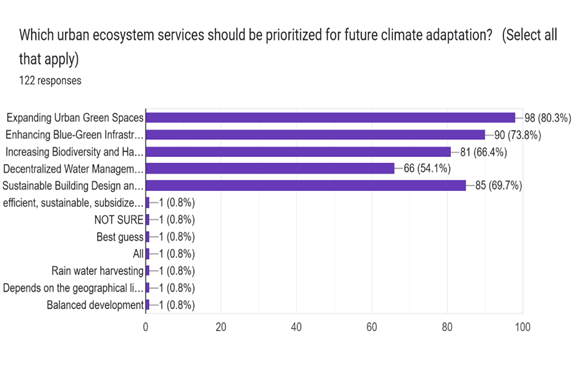
|
Figure 2 Prioritization
of Urban ESS for Future CCA Source Google Form
questionnaire by the Author |
According to the people, Enhancing Blue-Green Infrastructure for Flood Control and Increasing Biodiversity and Habitat Connectivity should be prioritised for future climate adaptation.
Figure 3

|
Figure 3 Enhancement of Urban ESS for CCA Source Google Form
questionnaire by the Author |
Technological advancement like IoT-Based Environmental Monitoring (Air Quality, Heat, Water Levels), GIS and Remote Sensing for Ecosystem Mapping, Smart Green Infrastructure (e.g., automated irrigation, adaptive green walls) & Circular Economy Approaches for Waste and Water Management can enhance urban ecosystem services for climate change adaptation.
Figure 4

|
Figure 4 Implementation of urban ESS Source Google Form
questionnaire by the Author |
Better policy integration implementation, Cross-Sector Collaboration (Govt, NGOs, Private Sector) & Community-Based Initiatives for Green Infrastructure can improve the implementation of ecosystem services of urban planning and governance.
Figure 5
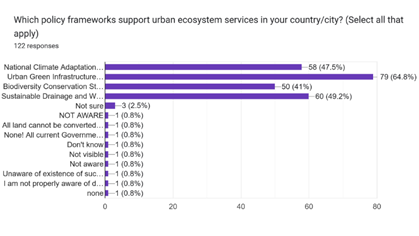
|
Figure 5 Framework
of urban ESS Source Google Form
questionnaire by the Author |
Urban Green Infrastructure Policies are the most important framework that supports urban ecosystem services.
Figure 6
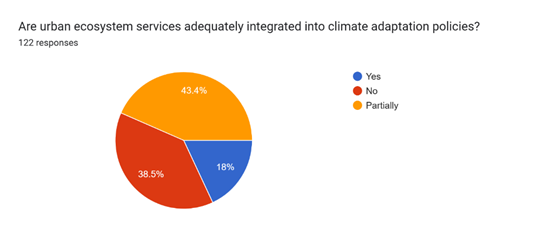
|
Figure 6 Integration of Urban ESS into CCA Policies Source Google Form
questionnaire by the Author |
Urban Ecosystem Services are partially integrated into climate change adaptation policies
Figure 7
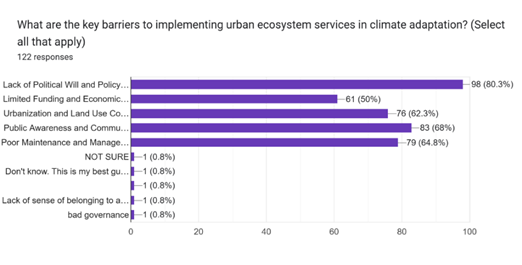
|
Figure 7 Barriers to implementing urban ESS Source Google Form
questionnaire by the Author |
Figure 8
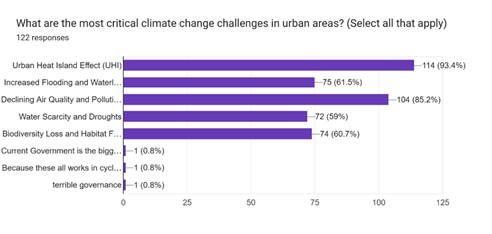
|
Figure 8 Critical
Climate Change Challenge in Urban ESS Source Google Form
Questionnaire by the Author |
The most critical climate change challenges in urban areas are Urban Heat Island Effect (UHI), Increased Flooding and Waterlogging, Declining Air Quality and Pollution, Water Scarcity and Droughts & Biodiversity Loss and Habitat Fragmentation
Figure 9

|
Figure 9 Usage
of urban ESS for CCA Source Google Form
questionnaire by the Author |
More than half of the participants have observed interventions based on ecosystem services in urban areas to address climate change.
Figure 10

|
Figure 10 Role of urban ESS in addressing CCA Source Google Form
questionnaire by the Author |
Urban ecosystem services play an important role in Carbon Sequestration (Tree Planting and Greenery), Absorption of Particulate Matter (PM2.5, PM10) & Cooling Microclimates to Reduce Smog Formation.
Figure 11

|
Figure 11 Urban ESS mitigating Urban Heat Stress Source Google Form
questionnaire by the Author |
Urban Tree Canopy Cover, Water Bodies (Lakes, Wetlands, Urban Rivers), Permeable Surfaces and Vegetated Swales & Green Roofs and Vertical Gardens are ecosystem services which are effective in mitigating urban heat stress.
Figure 12

|
Figure 12 Wetlands
and Water Bodies in Flood Mitigation Source Google Form
questionnaire by the Author |
Urban Wetlands and water bodies are effective in flood mitigation.
3.2. Survey and Interview Analysis
3.2.1. Introduction
To interpret the qualitative insights gathered through resident surveys and stakeholder interviews, a thematic content analysis (TCA) was conducted. The analysis aimed to identify recurring patterns of perception, experience, and awareness regarding urban ecosystem services (UES) and their contribution to climate change adaptation within Dwarka, New Delhi. Data from open-ended questionnaire responses and semi-structured interviews were transcribed, coded, and organized using a hybrid inductive–deductive approach. This method allowed themes to emerge organically while aligning them with the established categories of ecosystem services—Regulating, Supporting, Cultural, and Provisioning—under the Millennium Ecosystem Assessment framework.
3.2.2. Coding and Theme Development
Initial open coding generated over 120 descriptive codes, which were then condensed into subthemes and five main themes representing how residents perceive, experience, and engage with urban ecosystem services in their neighbourhood. NVivo 14 software facilitated data organization and clustering of codes into broader thematic categories.
Table 1
|
Table 1 Thematic Content Analysis of Urban Ecosystem Services and Climate Adaptation in Dwarka |
|||
|
Theme |
Subtheme |
Illustrative Quote (Participant) |
Interpretation / Adaptation Linkage |
|
Regulating Ecosystem Services |
Microclimate regulation; Air purification; Flood
mitigation |
“The parks around our block keep it cooler, even
during the hottest days.” (Resident, Sector 12) |
Vegetation and tree canopy reduce urban heat
island effects, providing natural cooling and thermal comfort. |
|
“The plantation drives have reduced dust and air
pollution near our homes.” (Resident, Sector 10) |
Reflects recognition of vegetation’s role in
improving air quality and health resilience. |
||
|
Cultural and Social Ecosystem Services |
Recreation and leisure; Stress relief; Community
bonding |
“Evening walks in the park help me feel calm
after a busy day.” (Teacher, Sector 6) |
Parks serve as informal adaptation spaces by
promoting mental well-being and social cohesion. |
|
“Festivals in the community garden bring everyone
together.” (Resident, Sector 5) |
Social networks enhanced through green spaces
contribute to collective adaptive capacity. |
||
|
Supporting Ecosystem Services |
Biodiversity value; Habitat creation; Soil and
water retention |
“We have started seeing more birds and
butterflies after the new plantation.” (Resident, Sector 9) |
Indicates ecological health and biodiversity
support, which strengthen long-term adaptation. |
|
Governance and Institutional Factors |
Maintenance issues; Policy implementation gaps;
Awareness deficit |
“Authorities plant trees but don’t maintain
them—most dry out after a few months.” (Community member, Sector 23) |
Highlights governance and institutional
inefficiencies affecting sustainable ecosystem management. |
|
“People don’t know how green areas help during
heat waves.” (Planner, DDA) |
Suggests the need for environmental literacy and
adaptive governance. |
||
|
Community-Based Adaptation and Participation |
Local initiatives; Stewardship; Awareness
campaigns |
“Our residents’ group cleans the park every
Sunday—it’s our responsibility.” (Youth volunteer, Sector 14) |
Reflects community-driven adaptation actions that
sustain local ecosystems. |
|
“We collect rainwater from rooftops for garden
irrigation.” (Resident, Sector 19) |
Demonstrates active citizen engagement in
small-scale climate resilience measures. |
||
|
Source: Survey & Interviews by the Author |
|||
3.2.3. Discussion
The analysis revealed that residents strongly associate green and blue spaces with thermal comfort, air quality improvement, and psychological relief—indicating intuitive awareness of regulating and cultural ecosystem services. However, institutional and governance challenges emerged as a recurring barrier, particularly in maintenance and policy enforcement. The presence of strong community-led initiatives, such as plantation drives and rainwater harvesting, demonstrates grassroots-level adaptation potential aligned with the principles of ecosystem-based adaptation (EbA).
Residents’ perceptions showed a high degree of dependence on tangible services (e.g., shade, cooling, cleanliness) but limited understanding of ecological processes (e.g., carbon sequestration, biodiversity support). This gap underscores the importance of education, awareness campaigns, and participatory planning for mainstreaming ecosystem services into urban adaptation strategies.
3.2.4. Conclusion
The thematic content analysis underscores that ecosystem services in Dwarka serve both environmental and social adaptation functions. Regulating and cultural services were the most recognized, while supporting and provisioning services were less visible to residents. Effective governance and community engagement emerged as critical determinants of sustainable adaptation outcomes. These insights form the basis for developing localized adaptation indicators and policy recommendations integrating ecosystem services into Dwarka’s urban planning framework.
4. CONCLUSIONS
The study reaffirms that ecosystem services form a robust basis for developing climate adaptation indicators, particularly within the complex socio-ecological fabric of rapidly urbanizing regions like Dwarka Sub-city, Delhi. Dwarka’s evolving urban landscape—characterized by fragmented green spaces, altered hydrological systems, and growing climate vulnerabilities—demonstrates the urgent need to recognize and quantify the role of ecosystem functions in supporting urban resilience. By assessing key ecosystem service-based indicators such as vegetation cover, surface temperature regulation, stormwater retention, biodiversity potential, and accessibility to urban green spaces, the research highlights how ecological assets can directly influence the adaptive capacity of urban settlements.
Integrating these indicators into Dwarka’s planning and governance frameworks can enhance data-driven decision-making and strengthen the linkage between environmental sustainability and climate adaptation. Moreover, recognizing ecosystem services as critical urban infrastructure shifts the focus from reactive measures—such as flood mitigation and heat stress management—to proactive, nature-based adaptation strategies.
In conclusion, embedding ecosystem service-based indicators into Dwarka’s climate adaptation framework can guide policymakers, planners, and citizens toward a more resilient, inclusive, and sustainable urban future. Future research should prioritize participatory assessment methods, spatial mapping of ecosystem functions, and long-term monitoring to refine indicator applicability and ensure that ecosystem-based adaptation becomes a central strategy in Delhi’s climate resilience agenda.
CONFLICT OF INTERESTS
None.
ACKNOWLEDGMENTS
None.
REFERENCES
Andersson, E., Barthel, S., Borgström, S., et al.
(2014). Reconnecting Cities to the Biosphere:
Stewardship of Green Infrastructure and Urban Ecosystem Services. AMBIO, 43(4),
445–453. https://doi.org/10.1007/s13280-014-0506-y
Braun, V., & Clarke, V. (2006). Using Thematic Analysis in Psychology. Qualitative Research in Psychology, 3(2), 77–101. https://doi.org/10.1191/1478088706qp063oa
Buizer, M., Elands, B., & Vierikko, K. (2016). Governing Cities Reflexively—The Biocultural Diversity Concept as an Alternative to Ecosystem Services. Environmental Science & Policy, 62, 7–13. https://doi.org/10.1016/j.envsci.2016.03.003
Creswell, J. W., & Plano Clark, V. L. (2018). Designing and Conducting Mixed Methods Research (3rd ed.). SAGE.
Dang, A. N., Jackson, B. M., Benavidez, R., & Tomscha, S. A. (2021). Review of Ecosystem Service Assessments: Pathways for Policy Integration in Southeast Asia. Ecosystem Services, 49, 101266. https://doi.org/10.1016/j.ecoser.2021.101266
Elmqvist, T., Setälä, H., Handel, S. N., van der Ploeg, S., Aronson, J., Blignaut, J. N., Gómez-Baggethun, E., Nowak, D. J., Kronenberg, J., & de Groot, R. (2015). Benefits of Restoring Ecosystem Services in Urban Areas. Current Opinion in Environmental Sustainability, 14, 101–108. https://doi.org/10.1016/j.cosust.2015.05.001
Ernstson, H., & Sörlin, S. (2013). Ecosystem Services as Technology of Globalization: On Articulating Values in Urban Nature. Ecological Economics, 86, 274–284. https://doi.org/10.1016/j.ecolecon.2012.09.012
Evers, C. R., Wardropper, C. B., Branoff, B., Granek, E. F., Hirsch, S. L., Link, T. E., Olivero-Lora, S., & Wilson, C. (2018). The Ecosystem Services and Biodiversity of Novel Ecosystems: A Literature Review. Global Ecology and Conservation, 13, e00362. https://doi.org/10.1016/j.gecco.2017.e00362
Gómez-Baggethun, E., & Barton, D. N. (2013). Classifying and Valuing Ecosystem Services for Urban Planning. Ecological Economics, 86, 235–245. https://doi.org/10.1016/j.ecolecon.2012.08.019
Haase, D., Larondelle, N., Andersson, E., Artmann, M., Borgström, S., Breuste, J., Gomez-Baggethun, E., Gren, Å., Hamstead, Z., Hansen, R., Kabisch, N., Kremer, P., Langemeyer, J., Rall, E., McPhearson, T., Pauleit, S., Qureshi, S., Schwarz, N., Voigt, A., & Elmqvist, T. (2014). A Quantitative Review of Urban Ecosystem Service Assessments: Concepts, Models, and Implementation. AMBIO, 43(4), 413–433. https://doi.org/10.1007/s13280-014-0504-0
Intergovernmental Panel on Climate Change. (2022). Climate change 2022: Impacts, adaptation and vulnerability. Cambridge University Press. https://doi.org/10.1017/9781009325844
Kabisch, N., Frantzeskaki, N., Pauleit, S., Naumann, S., Davis, M., Artmann, M., Haase, D., Knapp, S., Korn, H., Stadler, J., Zaunberger, K., & Bonn, A. (2016). Nature-Based Solutions to Climate Change Mitigation and Adaptation in Urban Areas: Perspectives on Indicators, Knowledge Gaps, Barriers, and Opportunities for action. Ecology and Society, 21(2), 39. https://doi.org/10.5751/ES-08373-210239
McPhearson, T., Pickett, S. T. A., Grimm, N., Niemelä, J., Alberti, M., Elmqvist, T., Weber, C., Haase, D., Breuste, J., & Qureshi, S. (2016). Advancing Urban Ecology Toward a Science of Cities. BioScience, 66(3), 198–212. https://doi.org/10.1093/biosci/biw002
Millennium Ecosystem Assessment. (2005). Ecosystems and Human Well-Being: Synthesis. Island Press.
Munang, R., Thiaw, I., Alverson, K., Liu, J., & Han, Z. (2013). The Role of Ecosystem Services in Climate Change Adaptation and Disaster Risk Reduction. Current Opinion in Environmental Sustainability, 5(1), 47–52. https://doi.org/10.1016/j.cosust.2013.02.002
Nagendra, H., Bai, X., Brondízio, E., & Lwasa, S. (2018). The Urban South and the Predicament of Global Sustainability. Nature Sustainability, 1(7), 341–349. https://doi.org/10.1038/s41893-018-0101-5
Pandey, R., Alatalo, J. M., Thapliyal, K., Chauhan, S., Archie, K. M., Gupta, A. K., Jha, S. K., & Kumar, M. (2018). Climate Change Vulnerability in Urban Slum Communities: Investigating Household Adaptation and Decision-Making Capacity in the Indian Himalaya. Ecological Indicators, 90, 379–391. https://doi.org/10.1016/j.ecolind.2018.03.031
Raymond, C. M., Frantzeskaki, N., Kabisch, N., Berry, P., Breil, M., Nita, M. R., Geneletti, D., & Calfapietra, C. (2017). A Framework for Assessing and Implementing the Co-Benefits of Nature-Based Solutions in Urban Areas. Environmental Science & Policy, 77, 15–24. https://doi.org/10.1016/j.envsci.2017.07.008
Revi, A., Satterthwaite, D., Aragón-Durand, F., Corfee-Morlot, J., Kiunsi, R., Pelling, M., Roberts, D., & Solecki, W. (2014). Urban Areas. In Climate Change 2014: Impacts, Adaptation, and Vulnerability. Part A: Global and Sectoral Aspects (pp. 535–612). Cambridge University Press.
Saaty, T. L. (2008). Decision Making with the Analytic Hierarchy Process. International Journal of Services Sciences, 1(1), 83–98. https://doi.org/10.1504/IJSSCI.2008.017590
Sharma, D., & Tomar, S. (2010). Mainstreaming Climate Change Adaptation in Indian Cities. Environment and Urbanization, 22(2), 451–465. https://doi.org/10.1177/0956247810377390
Singh, C., Madhavan, M., Arvind, J., & Bazaz, A. (2021). Climate Change Adaptation in Indian cities: A Review of Existing Actions and Spaces for Triple Wins. Urban Climate, 36, 100783. https://doi.org/10.1016/j.uclim.2021.100783
Singh, J., Karmakar, S., PaiMazumder, D., Ghosh, S., & Niyogi, D. (2020). Climate Change Impacts on Urban Flooding: A Case Study of Indian Cities. Environmental Research Letters, 15(7), 074033. https://doi.org/10.1088/1748-9326/ab8980
Singh, K., Singh, R., & Tewari, S. (2021). Ecosystem Restoration: Challenges and Opportunities for India. Restoration Ecology, 29(5), e13341. https://doi.org/10.1111/rec.13341
|
|
 This work is licensed under a: Creative Commons Attribution 4.0 International License
This work is licensed under a: Creative Commons Attribution 4.0 International License
© IJETMR 2014-2025. All Rights Reserved.


